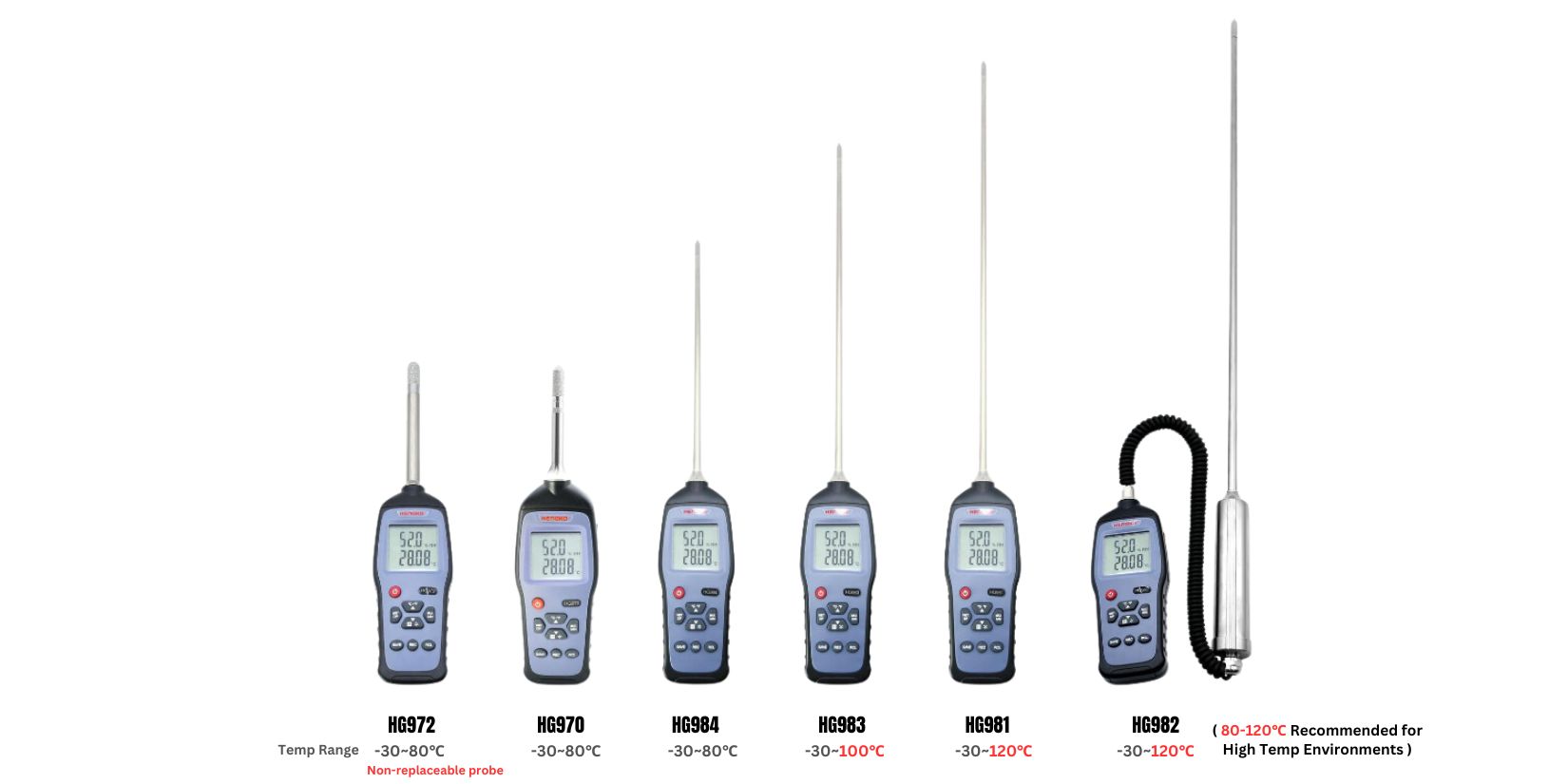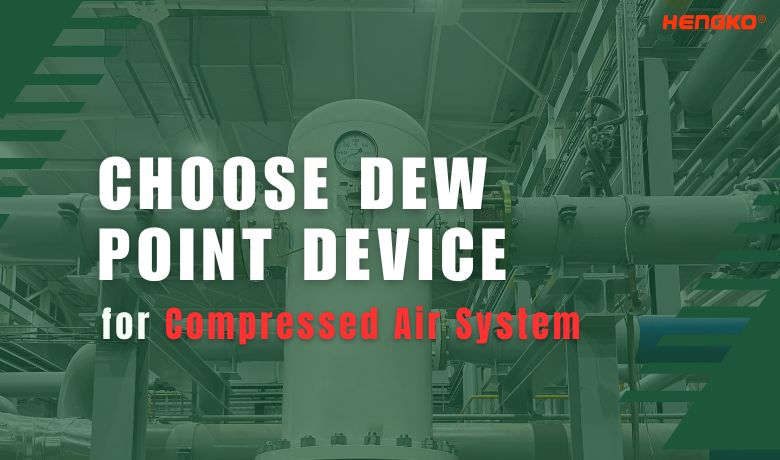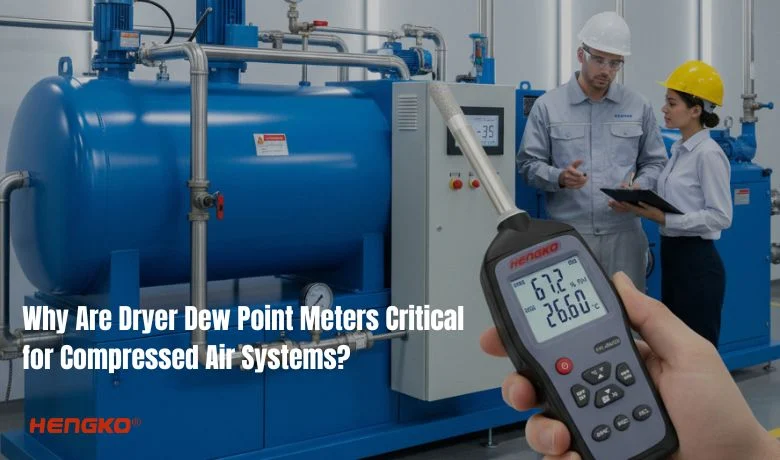Dew point measurement: The cornerstone of compressed air purity.
The quality of compressed air is often overlooked, yet it’s a critical factor in the efficiency and reliability of countless industrial processes. Moisture, a common contaminant, can wreak havoc on equipment, reduce production output, and compromise product quality. This is where dew point measurement comes into play. By accurately determining the temperature at which water vapor condenses, dew point measurement provides invaluable insights into compressed air quality.
In this guide, we’ll delve into the world of dew point measurement devices, helping you select the perfect tool to safeguard your compressed air system and optimize your operations.
Understanding Dew Point in Compressed Air Systems
Ce este punctul de rouă?
Punct de rouă is the temperature at which air becomes saturated with water vapor and begins to condense into liquid water.
In the context of compressed air systems, it’s the temperature at which water vapor in the compressed air will condense into liquid form.
www.processsensing.com
www.generon.com
The Impact of Dew Point on Compressed Air Quality
Moisture in compressed air can have a detrimental impact on system performance, safety, and efficiency. Here’s how:
www.atlascopco.com
- Equipment Damage: Liquid water can cause severe damage to pneumatic tools, valves, cylinders, and other components. Corrosion, erosion, and hydraulic lock are common issues.1. Combating That Killer of Industrial Pneumatic Systems – Water – Technical Articles
control.com
- Product Contamination: Moisture can contaminate products, especially in industries like pharmaceuticals, food processing, and electronics.
- Eficiență redusă: Water vapor increases the volume of compressed air, reducing compressor efficiency and increasing energy consumption.
- System Performance Issues: Moisture can cause icing in pneumatic systems, leading to malfunctions and downtime.1. Air Motor Icing – Do you have an icing problem? – Graco Inc.
www.graco.com
- Safety Hazards: In certain applications, moisture can create hazardous conditions, such as in welding or spray painting.
By accurately measuring dew point, you can identify potential problems and take corrective actions to protect your equipment, products, and personnel.
Key Considerations for Choosing a Dew Point Device for Compressed Air
Accuracy and Measurement Range
Explicație: Precision in dew point measurements is crucial for maintaining optimal air quality in compressed air systems.Range Requirements: Different applications have varying dew point needs, such as extremely dry air systems versus environments with higher humidity levels.
Timp de răspuns
Explicație: A quick response time is essential for real-time monitoring and making timely adjustments to the system.Application Examples: Fast response times can prevent system failures or quality issues in scenarios where immediate action is necessary.
Measurement Technology
Types: Common technologies include capacitive, chilled mirror, and optical measurement methods.Suitability for Compressed Air: Each technology has its pros and cons when it comes to testing compressed air quality. For example, capacitive sensors are generally more robust, while chilled mirror devices offer high accuracy.
Ease of Integration
Compatibilitate: Ensure the dew point device can be seamlessly integrated into existing compressed air systems.Installation Requirements: Consider factors that contribute to a hassle-free installation and operation, such as the device’s size, power requirements, and connectivity options.
Calibration and Maintenance
Calibration Needs: Regular calibration is necessary to maintain the device’s accuracy. Evaluate the frequency and ease of calibration.Maintenance Requirements: Typical maintenance tasks should be assessed for their impact on the device’s performance and overall system efficiency.

Types of Dew Point Devices for Compressed Air Systems
Portable Dew Point Meters
Description:
Portable dew point meters are handheld devices designed for on-the-spot measurements and temporary setups. They typically feature:
- Compact, lightweight design
- Battery-powered operation
- Digital displays for easy reading
- Quick-connect fittings for various sampling points
- Data logging capabilities
Ideal Use Cases:
- Spot checks at multiple locations
- Troubleshooting moisture issues
- Verifying fixed system readings
- Temporary monitoring during maintenance or system changes
Beneficii:
- Flexibility to measure dew point at different locations
- Easy to transport between facilities or measurement points
- Allows for quick assessments without permanent installation
- Useful for periodic audits and quality control checks
Fixed Dew Point Transmitters
Description:
Fixed dew point transmitters are permanently installed devices for continuous monitoring. Key features include:
- Robust construction for long-term industrial use
- Various output options (e.g., 4-20mA, Modbus)
- Alarm capabilities for exceeding set thresholds
- Options for hazardous area certifications
- Some models include local displays and controls
Ideal Use Cases:
- Continuous monitoring of critical processes
- Integration with building management or SCADA systems
- Long-term trend analysis of air quality
- Automated control of air treatment equipment
Beneficii:
- Provides constant, real-time data on air quality
- Enables proactive maintenance and early problem detection
- Supports automated control systems for optimized air treatment
- Allows for long-term data logging and analysis
- Can be integrated with other process control parameters for comprehensive system management
Both types of devices play crucial roles in maintaining compressed air quality, with the choice depending on specific application needs, monitoring frequency, and system integration requirements.
Budget and Investment Considerations
Cost vs. Benefit Analysis
Balancing Initial Costs with Benefits: Investing in dew point measurement devices involves upfront costs, but the benefits often outweigh these initial expenses. Accurate dew point measurement ensures optimal performance and efficiency of compressed air systems, which can lead to significant cost savings over time. Key benefits include:- Preventing Equipment Damage: By avoiding moisture-related issues such as corrosion and hydraulic lock, businesses can reduce repair and replacement costs.
- Maintaining Product Quality: Ensuring dry air prevents contamination, which is crucial in industries like pharmaceuticals and food processing.
- Improving Efficiency: Accurate dew point measurement helps maintain compressor efficiency, reducing energy consumption and operational costs.
Long-Term Value
Considerations for Long-Term Reliability and Cost Savings: Investing in high-quality dew point measurement devices can provide substantial long-term value through:- Enhanced System Reliability: Continuous monitoring helps detect and address moisture issues before they cause significant damage or downtime.
- Energy Savings: Efficient moisture control can lead to lower energy costs. For example, dew point dependent switching (DDS) in desiccant dryers can save up to 80% in energy costs, making the investment pay off within a year.
- Reduced Downtime: Proactive maintenance enabled by accurate dew point monitoring minimizes unexpected system failures, ensuring uninterrupted operations.
- Compliance and Quality Assurance: Maintaining the required dew point levels ensures compliance with industry standards (e.g., ISO8573.1) and enhances product quality, reducing waste and rework.
Evaluating Vendors and Products
Reputable Brands
Several leading manufacturers are known for their high-quality dew point measurement devices:
- Vaisala: Renowned for their advanced sensor technology and reliable instruments.
- Elcometer: Offers rugged dew point meters designed for harsh industrial environments.
- Alpha Moisture Systems: Specializes in dewpoint instrumentation for industrial gases and trace moisture measurement.
- Senseca: Provides a range of dew point measurement solutions for various applications.
- HENGKO: Supply kinds of dew point sensor, transmitter included handheld dew point meter, wall mount dew point transmitter to testing for your air pressure system.
Other notable brands include MICHELL INSTRUMENTS, CS Instruments, and Testo.
Concluzie
Choosing the appropriate dew point measurement device is crucial for maintaining and improving compressed air quality. The right device can:
- Ensure consistent air quality across your system
- Prevent moisture-related equipment damage and product contamination
- Optimize energy efficiency and reduce operational costs
- Facilitate compliance with industry standards and regulations
- Enable proactive maintenance and minimize unexpected downtime
The selection process involves careful consideration of factors such as accuracy, measurement range, response time, and integration capabilities. Additionally, understanding the different types of devices available and their suitability for specific applications is essential for making an informed decision.
By carefully selecting the right dew point device, you can significantly enhance the performance, efficiency, and reliability of your compressed air system. This investment will contribute to improved product quality, reduced operational costs, and increased overall system effectiveness.






